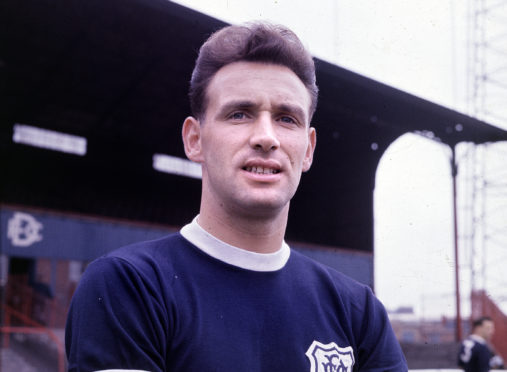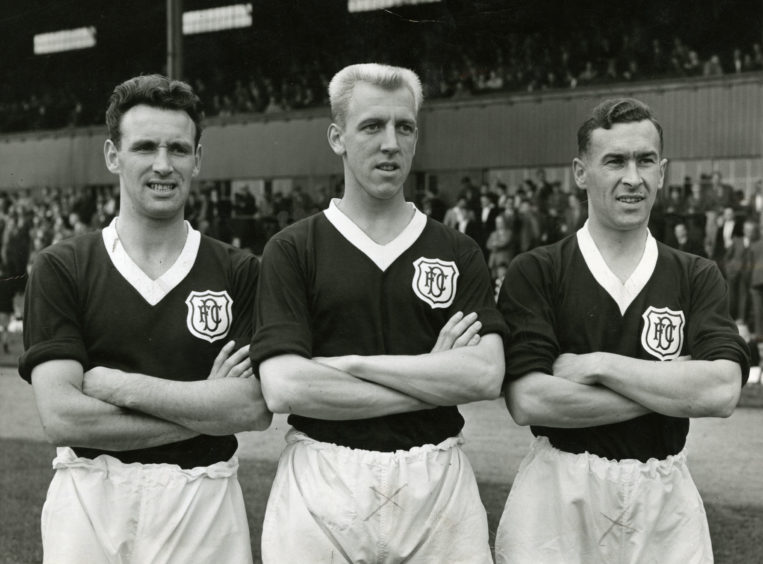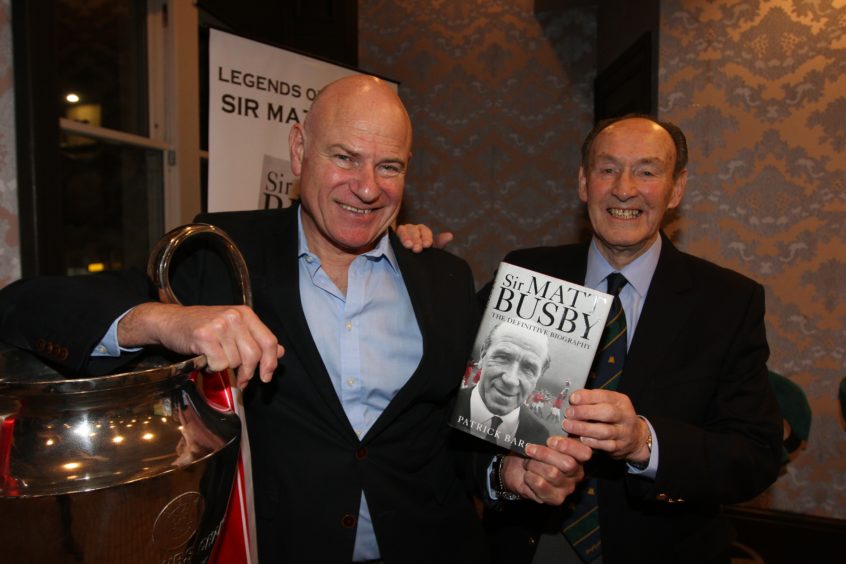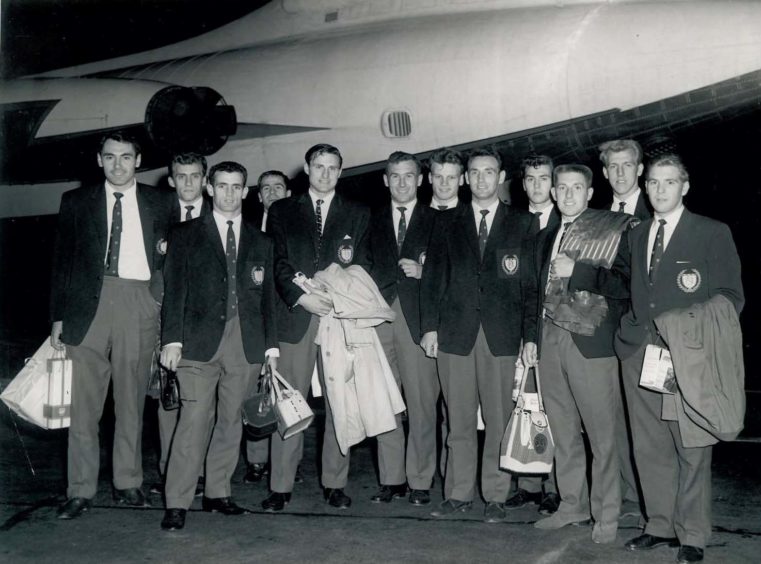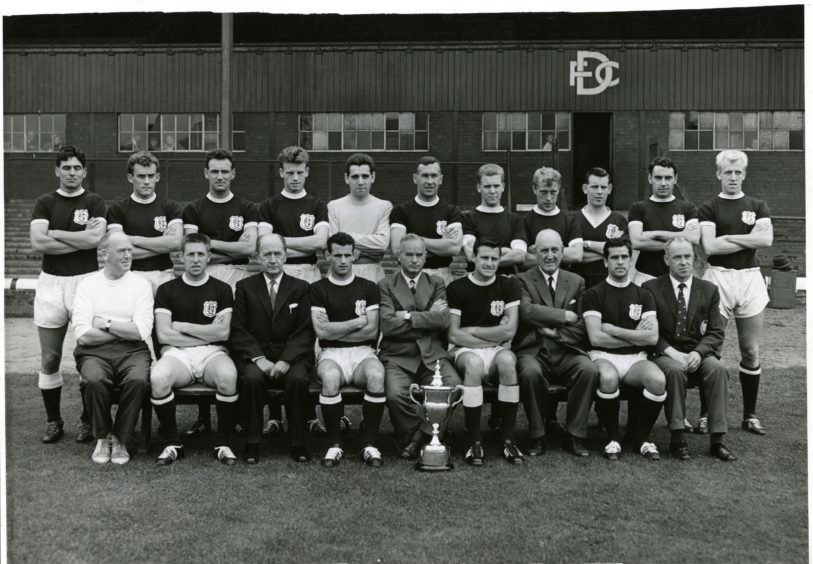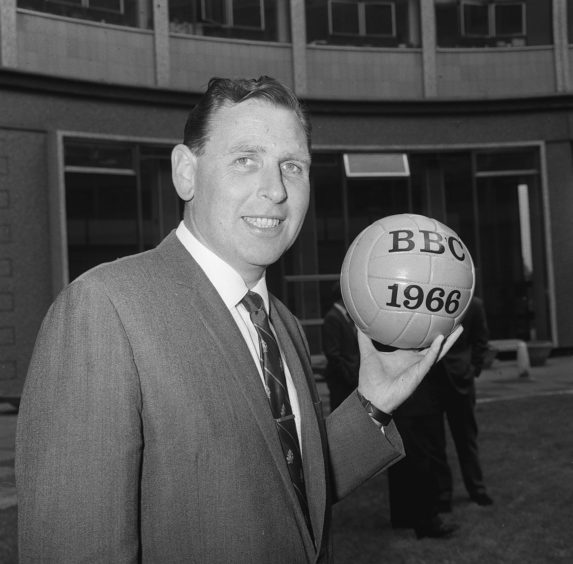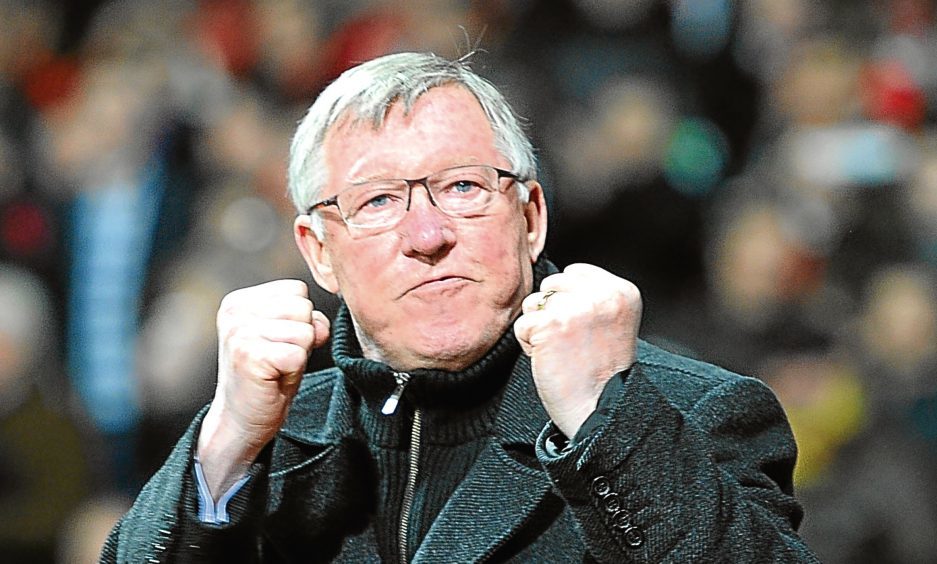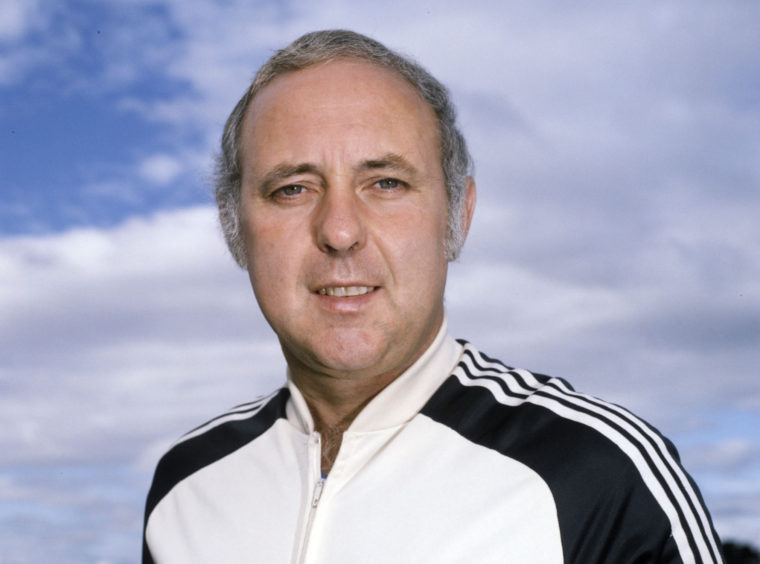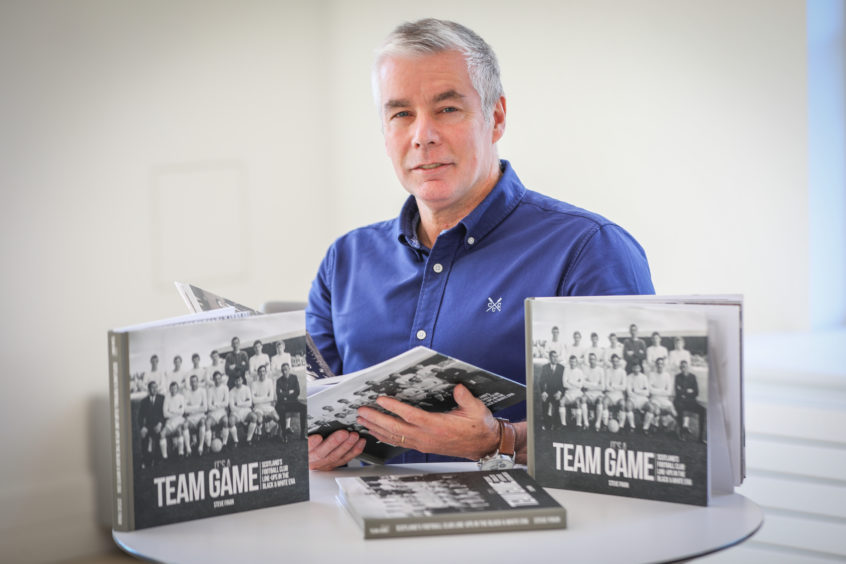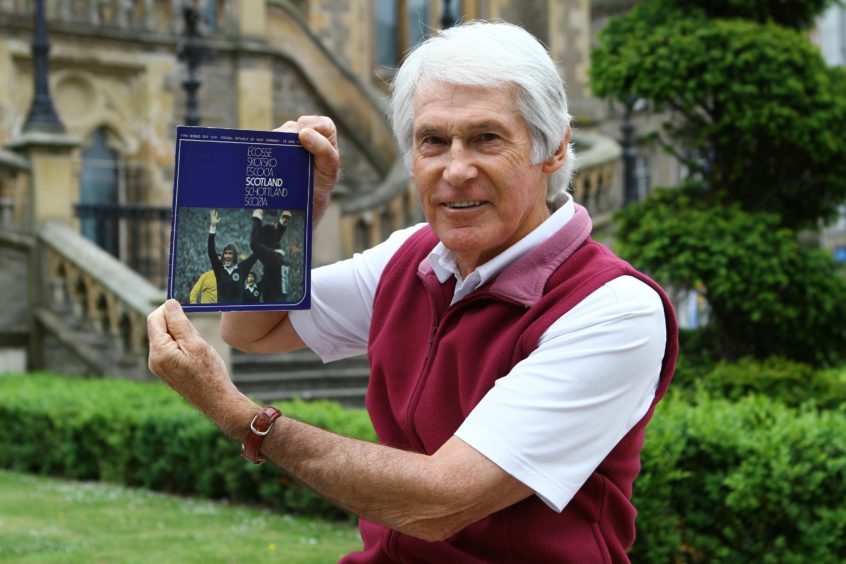Dundee FC legend Bobby Seith is recovering in hospital after having his right leg amputated.
The former Dens Park right-half, who was part of Dundee’s 1961-62 title-winning side, was suffering from a vascular blockage.
Mr Seith, who is now 88, joined Dundee in 1960 and under the guidance of Bob Shankly he was also a key player in the club’s surge to the European Cup semi-final in 1962-63.
Indeed, he captained the side against AC Milan in the San Siro in the absence of injured skipper Bobby Cox.
Mr Seith had been suffering from pain in the leg which gradually started to get worse before he was taken to hospital.
Doctors discovered Mr Seith’s leg artery was blocked and surgeons were left with no option but to amputate the leg above the knee.
The Dens Park hero’s son Bob said his dad was in good spirits in Ninewells Hospital where he is battling back to health.
Strong enough to get through this
“He is so upbeat and determined to get out of hospital and overcome this and I have no doubt that he will,” he said.
“My dad is a very intelligent man and he recognises this is something that will be difficult but he is still strong enough – physically and emotionally – to get through this.
“Up until very recently we would always say that dad could only take a few steps before he would break into a run.
“He was very fit and hopefully that will carry him through now.
“The strength of personality that he displayed on the football field he is now displaying in hospital.
“He’s still got this determination and this drive that he’s always had in his life.”
The great-grandfather, who lives with wife Jean in Broughty Ferry, has also sent a message of thanks from his hospital bed to Dundee supporters who have sent him good wishes after learning he had been admitted.
Mr Seith joined Burnley from Monifieth Tayside and signed a professional contract with the English club in 1949.
He made his first-team debut against Manchester United’s celebrated Busby Babes at Old Trafford in October 1953, which was the beginning of a Burnley career that would see him play 238 games.
English league winner
Mr Seith helped Burnley win the English league championship before moving north and signing for Dundee in 1960 after handing in a transfer request at Turf Moor following a disagreement with Clarets chairman Bob Lord.
When he arrived at Dens from the English top flight, he brought with him priceless experience and big game knowledge.
The right-half was seen by many as the final piece in a defensive jigsaw which included Bobby Cox and Ian Ure.
Dundee’s 1961-62 title winning side – Liney, Hamilton, Cox, Seith, Ure, Wishart, Smith, Penman, Cousin, Gilzean and Robertson – still trips off the tongue of every supporter.
With Bob Shankly in charge, a fantastic season was crowned by clinching the club’s only league title, where a 3-0 win over St Johnstone saw them beat off the challenge of Rangers in what, until that final day, had been a nip-and-tuck race.
Best side he had ever seen
This allowed Mr Seith the opportunity to compete in the European Cup which had been denied him by his departure from Burnley after winning the English league title.
Kenneth Wolstenholme, the legendary former BBC commentator, rated Dundee as one of the best sides he had ever seen after they defeated West German champions Cologne 8-1 at Dens Park in the preliminary round.
Mr Seith joined the Dens Park coaching staff in 1965 after giving up playing before being lured that same year to Ibrox by Rangers manager Scot Symon.
He resigned from Ibrox when Symon was sacked.
But one of his final contributions was to get a disillusioned Alex Ferguson’s career back on track.
Seith went on to become a manager in his own right soon after when Preston North End appointed him team boss.
After two seasons at Deepdale from 1968-70, he returned to Scotland to manage Hearts, spending four years in the Tynecastle hot seat.
Former Dundee United boss Jim McLean cited Seith and John Prentice as early influences on his own managerial career.
Continental approach to management
McLean highlighted Seith’s continental approach to the game which was in stark contrast to the traditional kick-and-rush style.
Steve Finan, author of a new examination of Jim McLean’s career, due to be published on May 18, said: “The 1960s were a time of great change in football tactics.
“The old 2-3-5 formation was still foremost in the minds of many coaches and players at the start of the decade, even after watching the great Hungarians new approach to the game in the 1950s.
“But by the end of the 60s, 4-4-2, 4-3-3, and more fluid positional interchanges were just a few of the innovations that had been seen.
“Every forward-thinking coach in Europe took note of what Helenio Herrerra’s Inter Milan were trying to do with their famed Catenaccio system.
“Then there were the great attacking sides, Madrid, Benfica and Manchester United who could sprinkle their teams with the world’s greatest players to score goals, without caring much about how many they let in.
“Young coaches and managers like McLean and Bobby Seith watched these developments with great interest and tried to incorporate what they were seeing into their own systems.
“When asked who he admired in the game, Jim would reel off Stein, Prentice…and Bobby Seith.
“Jim saw what Bobby was trying to do at Preston and, especially, when he returned north of the border to first be in charge of the Scottish youth team, then manage Hearts.
“Jim would, of course, face Bobby from dug-out to dug-out as a rival manager.
“But the ethos Bobby was preaching at Tynecastle was very similar to what Jim was trying to instil into his United side, and had been coaching at Dens Park before his departure.
“It was all about keeping the ball, getting his players to make runs that would create space, and then exploit that space with passes made at the right time.”
Mr Finan said matches between Hearts and United in the early 1970s were the nearest Scottish football at that time got to the way Italian league matches were played.
Criminal waste of talent
He said: “Indeed the first match after Jim was named as United boss was a 3-2 loss to Seith’s Hearts at Tynecastle, although Jim wasn’t in the dug-out yet.
“The return the following April saw an exact reversal, McLean’s United beat Seith’s Hearts 3-2.
“In October 1972 the next United meeting with Hearts was also 3-2 in United’s favour.
“Jim greatly admired Bobby’s teams and enjoyed the challenge of playing against Hearts.
“The two men would meet after games to discuss tactics, players and formations.
“Jim regarded it as a criminal waste of talent when Hearts parted company with Bobby early in the 1974-75 season.
“Jim could see that he had been building something special at Tynecastle.”
Former Hearts and Scotland international striker Donald Ford highlighted Seith’s attacking tactics after taking the Tynecastle job.
He said Seith’s signings of Drew Busby, Kenny Aird and Bobby Prentice opened the door for an unforgettable season which took Mr Ford all the way to the 1974 World Cup finals.
“I hope his recovery continues and that he gets home soon,” said Mr Ford, who now lives in Carnoustie.
“From my own perspective, the most prominent feature of his managerial career at Tynecastle was undoubtedly the signings he made of Drew Busby, Kenny Aird and Bobby Prentice.
“The 4-2-4 system he installed after their arrival produced a very strong, attacking team and, if I remember correctly, we were at or near the top of the league for two or three months of the 1973-74 season.
“Personally, I was lucky enough to be on the receiving end of the creation of a much increased number of goal opportunities, as the three different skills each displayed were just superb.
“Without a doubt, their signings opened the door for, selfishly, my own season to become unforgettable.”
Mr Seith was chief chiropodist for Dundee East after retiring from football.
His voice was also heard during his work for the BBC where he used to be up in the gantry giving match reports from Dens and Tannadice.
